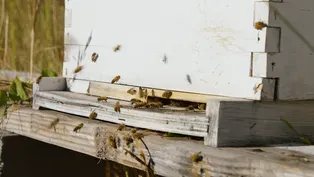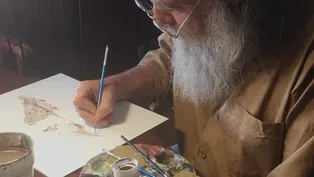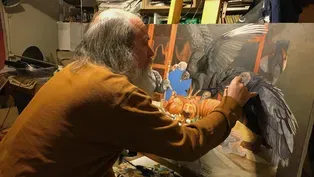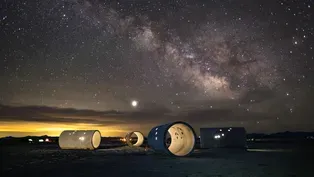
Passion Project
Season 3 Episode 3 | 26m 46sVideo has Closed Captions
Explore passion with artist Carel Brest van Kempen, a beekeeper & Nancy Holt’s Sun Tunnels
Passion —it’s what drives us to get up in the morning, put nose to the grindstone, and accomplish great things. We’ll meet three people with passion projects of their own, touring Emigration Canyon with artist Carel Brest van Kempen, learning from the industriousness of bees with beekeeper Adesina Daniel Oduntan, and connecting with land &the universe through Nancy Holt’s famous Sun Tunnels.
This Is Utah is a local public television program presented by PBS Utah
Funding for This Is Utah is provided by the Willard L. Eccles Foundation and the Lawrence T. & Janet T. Dee Foundation, and the contributing members of PBS Utah.

Passion Project
Season 3 Episode 3 | 26m 46sVideo has Closed Captions
Passion —it’s what drives us to get up in the morning, put nose to the grindstone, and accomplish great things. We’ll meet three people with passion projects of their own, touring Emigration Canyon with artist Carel Brest van Kempen, learning from the industriousness of bees with beekeeper Adesina Daniel Oduntan, and connecting with land &the universe through Nancy Holt’s famous Sun Tunnels.
How to Watch This Is Utah
This Is Utah is available to stream on pbs.org and the free PBS App, available on iPhone, Apple TV, Android TV, Android smartphones, Amazon Fire TV, Amazon Fire Tablet, Roku, Samsung Smart TV, and Vizio.
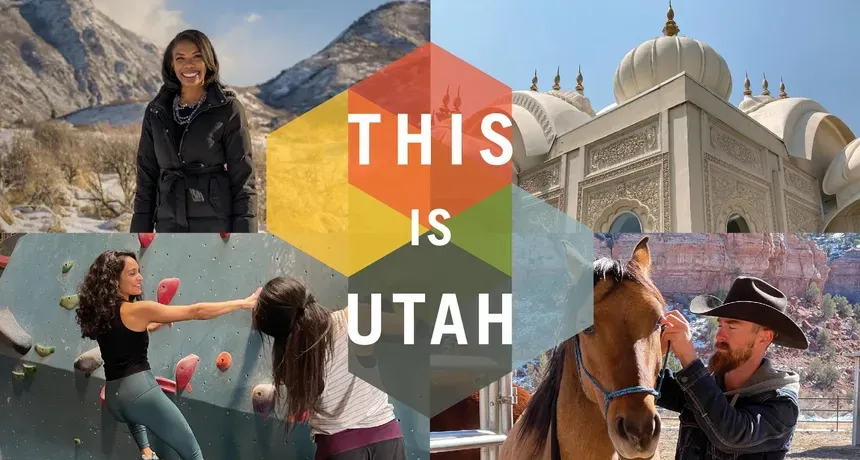
This is Utah
Liz Adeola travels across the state discovering new and unique experiences, landmarks, cultures, and people. We are traveling around the state to tell YOUR stories. Who knows, we might be in your community next!Providing Support for PBS.org
Learn Moreabout PBS online sponsorship(gentle music) - Welcome to the show!
I'm your host, Liz Adeola.
Many of us have had a lot more time on our hands to pick up a passion project or two or three or even four.
In this edition of, This is Utah, you'll meet Utahans who've taken their passion projects to the next level.
From a beekeeper whose passion is as sweet as honey to an artist you could call the Davy Crockett of the Wasatch Mountains.
Also, we invite you to get lost in the tranquility and vastness of Utah Sun Tunnels.
- [Narrator] Funding for This Is Utah is provided by The Willard L. Eccles Foundation, The Lawrence T. and Janet T. Dee Foundation, and the contributing members of PBS Utah.
Thank you.
(upbeat, funky music) - What do you see when you step outside?
Utah artist Carel Brest van Kempen sees the world.
Come discover how natural habitats and this Canyon inspire Karl to create his own stories on canvas.
- What's the difference between an artist and mutual fund.
Eventually the mutual fund will mature and start to make money.
(folk instrumental music) When I was a little kid, I wanted to grow up to be like the Audubon of the 20th century.
And I've always been interested in drawing, since I was old enough to get a hold of the pencil.
And, first started trying to paint when I was in grade school but I'd never been particularly good at it until I was in my late twenties.
I grew up in Emigration Canyon, just East of Salt Lake, and it was a great place to grow up.
There are a lot of memories at first, you know, I remember the first toad I ever found.
There were a lot of sagebrush lizards taming a lotta racers, snakes, just walk out my door and explore as far as I wanted to go and spend as much time as I could as a kid, just tromping around looking at the craters and these things, These poor wells are common up there and they were back then.
And so I've had a fascination with them since I was a kid.
You rarely see them in the daytime unless you accidentally flushing and They're nocturnal.
They hunt for insects at night.
I usually start out just doing sketches and refining those sketches.
And then once I have everything all established the way I want it the vision I have in trying to translate that vision onto dimensions, it's always a series of compromises.
You wind up.
No that doesn't quite I can't figure out how to make that work.
And sometimes the finished thing will be very different from the idea I started with.
I really learned about nature studying nature here in Utah but somehow from the time I was little, I really kind of got the big picture and and applied the principles that I saw to the global scale.
But I know so much more about the ecology of the Wasatch mountains than I do anywhere else.
If I'm hiking around here, I've got an Eagle eye, I can spot stuff that I would never spot anywhere else.
Cause I know the geometry and everything.
I know how that looks here.
[Birds Chirping] [Birds Chirping Again] - Swainson's thrush.
That's I think my favorite bird call up here.
You hear them in the evening, the tops of trees beautiful little warbly slooty call.
When I was about 11 years old, my friend Raymond and I were up here we found a horse figured it was a wild horse and we caught it.
We chased it.
We chased it and caught it.
And Jason got it, took it home, got in a lot of trouble from the guy who owned the horse.
A lot of interesting characters living up here at that time.
[Somber Music Plays] - One of the real interesting and infamous characters from immigration Canyon was Ruth Evans who opened Ruth's diner.
She bought that place in the thirties and the whole time that she ran that place, it was just single woman running this place.
It was really out in the middle of nowhere and there were two or three times that somebody tried to hold her up.
And both times she scared them out.
They'd never got a nickel.
She used to keep a loaded shotgun underneath the bar.
And I think she would have used it if she had to.
She would, she didn't take guff from any she was a tough, tough old lady.
We were pretty scared of her.
[Light Music Playing] When I was born, Immigration was a little rural town that was separate from Salt Lake City and was essentially working class people.
Property was inexpensive up there.
And by the time I graduated from high school that was well on its way to becoming a wealthy bedroom community for Salt Lake City.
When I was a kid, it was really heartbreaking to watch you know, my favorite places fall to a bulldozer but I've been watching that all my life.
And so I continued to spend a lot of time hiking up there.
And so it's been really interesting watching how nature has changed to adapt to, and to fail to adapt to the human changes.
[Leaves Rustling] - There aren't many kids around here that live in places like I lived, but you can see so much nature right here in the city.
You just got to look for it.
There's really nothing more interesting than nature.
And and ecology the way that the whole thing offered is the way that all the Plants and animals interact with each other and interact with their Habitat and how that changes over time or how it doesn't change.
And that's something that we're all part of.
I've always been interested in nature on a global scale.
Maybe it's because a big motivator for my painting is I'm painting stuff that I would love to see is is a way of seeing stuff that I can't see any other way.
- Its always a temptation to get polemical with artwork and to try to make a specific message about something that you care about.
And if you'd try, rather than communicating something specific to just try to make people think about something in a new way, that's what I'd try to do with my stuff is to just make it thought provoking, and then leave it up to the viewer to decide where they go with those thoughts.
[Music Plays] [UpBeat Music plays] The beehive is a symbol you'll spot all around Utah probably not as big as this one but each beehive big or small represents hard work.
And the state motto industry.
A major factor that convinced Daniel Oduntan to start his own beekeeping business here in the beehive state.
So this is the last part to put on and then this.
Is this good?
Yeah.
Now Where's your suit?
Wow.
But you're the pro I'm the novice so I gotta wear the suit.
Yeah you have to.
All right.
- And you hold it like this?
Yeah.
- Oh its heavy!
Yeah, Honey's heavy.
[Up beat music] - Filled with mirages and mystery, At times, Utah's desert landscape can be overwhelming or hard to grasp.
Since 1976, Nancy Holt's land art piece, The Sun Tunnels, have beckoned travelers to experience the enchanting beauty, that can't be found anywhere else on earth.
[Gong Ringing] [Gong Rings Again] [Gong Rings Again] [Gong Rings Again] - The sun tunnels were made by Nancy Holt who was an American artist who was born in 1938.
Nancy Holt first came out to the American West in 1968.
She was completely blown away by the landscape out here in the West.
And just the vastness of this desert.
- I had an overwhelming experience, it was as if my inner landscape and the outer landscape were identical, or you know.
It was like a Nirvana experience.
For three days, I didn't sleep, I was just euphoric And it's really at the beginning of my arch really And to this day, most of the roots off everything I do.
- The work consists of four concrete cylinders that are each nine feet in diameter and 18 feet long.
And the tunnels align with the sunrise and sunset of the sun on the summer and winter solstices.
The four tunnels also have constellations that are cut out through the tunnel.
And those four constellations are Draco Perseus, Columba, and Capricorn.
- Nancy Holt rented a studio in Salt Lake city, and she spent about a year living in Utah, creating this work.
She first started creating models and drawings in 73 and the work was completed in 1976.
- So when you create a work like this, it's out in the middle of the desert in Utah, in order for people to experience it to spread the story of the work.
Nancy Holt created a number of photographic series and also created a film.
The majority of the film is dedicated to the construction of sun tunnels.
Nancy was very much fond of skill and skilled laborers and she really respected the people that she worked with.
And I think in the film Sentinel she really wanted to honor that, to honor the labor that went into creating something like this.
And if you read some of her writing, she talks about how exciting it was to see this transition.
When she was working with these, the the pipe manufacturers who pour these concrete culverts working with them and seeing the shift that took place where they started to understand and take pride in the work that they were doing.
And it took an incredible amount of planning and forethought to execute and work like sentinels, where you have these four concrete centers that are each 22 tons.
She was working with 40 people to collaborate and organize.
For me as an artist, it's really inspiring to see that to see a work like this that took so much planning and so much forethought and organization.
[Light Music Plays] - Utah's Filled with great people to a site they would never have gone to - They wouldn't never about you otherwise, you know you're not, you know, I haven't, you had everything.
And they were amazed.
And I invited the local people, many of whom came.
This morning I had the map open and said, where can we go?
Not too far overnight.
And I looked in the West desert and went to sun tunnels.
I think a lot of times people are looking for something that not a lot of people know about.
That's kind of adventurous and out there, and that's kind of secluded and you know, the little secrets of the land.
And I think this is one of them.
That's something that you can come in, come in and find that a lot of people don't know about something called cool to experience.
- Most years there's usually between 100 and 200 people.
I think this is my seventh or eighth time being here in the summertime.
And I was out here once for the winter solstice.
- I think it's really amazing about pieces of land art.
You, your perspective changes as the light changes, And so you can't really see them.
They're concrete.
They blend in.
You can't really tell what it is until you get up close and personal.
And so you go on this like great journey.
There's like this great effort to get out to these remote spaces that you just know immediately why the artists chose to do what they did.
- When you're out in the middle of a desert like that, there's nothing to refer to.
You know, like there's, it's very bad, very overwhelming and you get dislocated.
The sculptured focuses your attention.
[Music Plays] - Nancy Holt was interested in raising questions about the way that we relate to landscape, how by changing our perception of landscape, we might completely shift our relationship with it.
And by placing these sun tunnels here, how does it change the way that we understand where we are on the planet, where we are in the universe?
- Out the Devin is like a long star, you know like all over your head.
And so the tunnels repeat that fact that the sun is shining through the star holes casting spots of light on a tunnel.
And then the configuration of stars is actually you're walking on the star and then you haven't met the planet because it's so bad there.
And because maybe you're walking on land never been walked on before.
I mean, that sensation is really exciting.
So you have this like sense of time, geologic time.
- So what's your passion project.
This is Utah's on Facebook, Instagram, and YouTube.
You can check us out online for behind the scenes photos or watch your favorite stories on demand and share what fun activity fuels you until next time.
I'm Liz Adeola.
And this is Utah.
Funding for this is Utah is provided by the Willard L. Eccles foundation the Lawrence T. and Janet T. Dee Foundation and the contributing members of PBS Utah.
Thank you.
[Ending Music]
Video has Closed Captions
Adesina Daniel Oduntan never imagined that his love for bees would bring him to Utah. (7m 21s)
Video has Closed Captions
Local painter Carel Brest van Kempen takes inspiration from the nature all around him. (8m 19s)
Get inspired by passion projects in this week's episode of This Is Utah. (30s)
Video has Closed Captions
Nancy Holt’s famous earthwork, Sun Tunnels, connects visitors to both land & the universe. (7m 38s)
Providing Support for PBS.org
Learn Moreabout PBS online sponsorshipThis Is Utah is a local public television program presented by PBS Utah
Funding for This Is Utah is provided by the Willard L. Eccles Foundation and the Lawrence T. & Janet T. Dee Foundation, and the contributing members of PBS Utah.


